| Amun | |||||
|---|---|---|---|---|---|
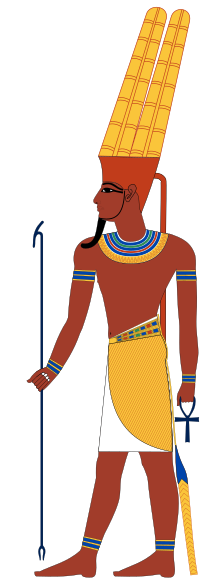 | |||||
| Name in hieroglyphs |
| ||||
| Major cult center | Thebes | ||||
| Symbol | two vertical plumes, the ram-headed Sphinx (Criosphinx) | ||||
| Consort |
Amunet Wosret Mut | ||||
| Offspring | Khonsu | ||||
| Equivalents | |||||
| Greek equivalent | Zeus | ||||


| Anhur | |
|---|---|
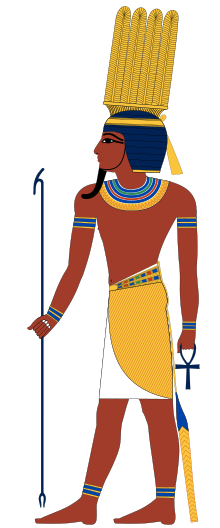 Anhur was depicted wearing a headdress of two or four tall feathers. | |
| Genealogy | |
| Parents | Ra |
| Siblings | Tefnut |
| Consort | Mehit |
| Anubis | ||||||
|---|---|---|---|---|---|---|
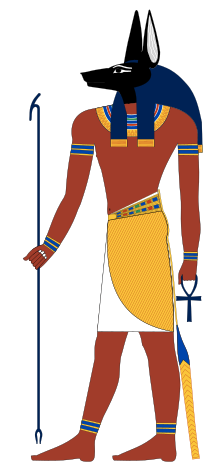 The
Egyptian god Anubis (a modern rendition inspired by New Kingdom tomb paintings) | ||||||
| Name in hieroglyphs |
| |||||
| Major cult center | Lycopolis, Cynopolis | |||||
| Symbol | the fetish, the flail | |||||
| Parents | Nepthys and Set or Osiris (Middle and New kingdom), or Ra only (Old kingdom). | |||||
| Consort | Anput | |||||
| Offspring | Kebechet | |||||
| Atum | ||||
|---|---|---|---|---|
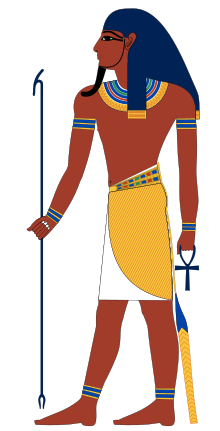 Atum, finisher of the world | ||||
| Name in hieroglyphs |
| |||
| Major cult center | Heliopolis | |||
| Genealogy | ||||
| Consort | Iusaaset or Nebethetepet | |||
| Children | Shu and Tefnut | |||
| Geb | |||||
|---|---|---|---|---|---|
 | |||||
| Name in hieroglyphs |
| ||||
| Symbol | Geese, Snakes, Bulls, Barley | ||||
| Genealogy | |||||
| Parents | Shu and Tefnut | ||||
| Siblings | Nut | ||||
| Consort | Nut | ||||
| Offspring | Osiris, Isis, Set, Nephthys, and sometimes Horus. | ||||
| Horus | |
|---|---|
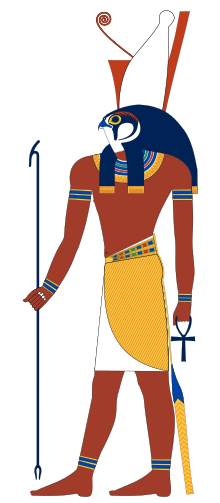 Horus was often the ancient Egyptians' national
tutelary deity. He was usually depicted as a falcon-headed man wearing the
pschent, or a red and white crown, as a symbol of kingship over the entire kingdom of Egypt. | |
| Major cult center | Nekhen, Edfu |
| Symbol | Eye of Horus |
| Genealogy | |
| Parents | Osiris and Isis |
| Siblings | Osiris, Isis, Set, and Nephthys (as Horus the Elder), Anubis (as Horus the Younger) |
| Consort | Serket (as Horus the Elder), Hathor (in one version) |
| Offspring | Imset, Hapi, Duamutef, Qebehsenuef (as Haroeris), Ihy |
| Khnum | ||||
|---|---|---|---|---|
God of the source of the Nile river | ||||
 the Egyptian god Khnum was usually depicted with the head of a ram. | ||||
| Name in hieroglyphs |
| |||
| Major cult center | Elephantine | |||
| Symbol | the potter's wheel | |||
| Consort | Heqet, Satet, Mehet-Weret, Menhit, Nebtu, Neith | |||
| Offspring | Heka and sometimes Ra | |||
| Khonsu | ||||||
|---|---|---|---|---|---|---|
 Khonsu in human form | ||||||
| Name in hieroglyphs |
| |||||
| Major cult center | Thebes | |||||
| Symbol | the moon disk, the sidelock, falcon, crook and flail, was-scepter | |||||
| Genealogy | ||||||
| Parents | Amun/ Ra and Mut/ Hathor | |||||
| Siblings | Maat, Apis, Tefnut, Sekhmet, Bast, Shu | |||||
| Consort | Bast | |||||
| Khonsu | ||||||
|---|---|---|---|---|---|---|
 Khonsu as falcon | ||||||
| Name in hieroglyphs |
| |||||
| Major cult center | Thebes | |||||
| Symbol | the moon disk, the sidelock, falcon, crook and flail, was-scepter | |||||
| Genealogy | ||||||
| Parents | Amun/ Ra and Mut/ Hathor | |||||
| Siblings | Maat, Apis, Tefnut, Sekhmet, Bast, Shu | |||||
| Consort | Bast | |||||
| Montu, Monthu, Mentu or Menthu | ||||
|---|---|---|---|---|
 | ||||
| Name in hieroglyphs |
| |||
| Major cult center | Hermonthis, Thebes, Medamud, El-Tod | |||
| Symbol | Sun disk, feathers, weapons | |||
| Consort | Raet-Tawy, Tjenenyet, Iunit | |||
| Nefertem | ||||||
|---|---|---|---|---|---|---|
 the Memphite god Nefertem with a water-lily headdress as a symbol of fragrance and beauty. | ||||||
| Name in hieroglyphs |
| |||||
| Major cult center | Memphis | |||||
| Symbol | the water-lily | |||||
| Parents | Ptah and Sekhmet or Bast | |||||
| Osiris | ||||
|---|---|---|---|---|
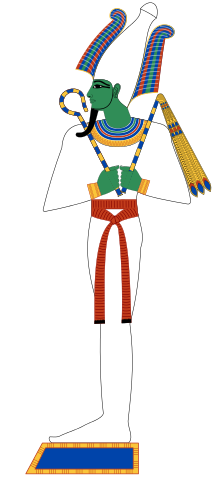 Osiris, lord of the dead, the underworld and rebirth. He had green skin because he ruled the dead, who "lived" on in the underworld. | ||||
| Name in hieroglyphs |
| |||
| Major cult center | Abydos | |||
| Symbol | Crook and flail, Atef crown, ostrich feathers, fish, mummy gauze | |||
| Genealogy | ||||
| Parents | Geb and Nut | |||
| Siblings | Isis, Set, Nephthys, Horus the Elder | |||
| Consort | Isis | |||
| Offspring | Horus, Anubis (in some accounts) | |||
| Ptah | |||||
|---|---|---|---|---|---|
 Ptah, in the form of a mummified man, standing on the symbol for Ma'at, holding a scepter or staff that bears the combined ankh-djed-was symbols | |||||
| Name in hieroglyphs |
| ||||
| Major cult center | Memphis | ||||
| Symbol | the djed pillar, the bull | ||||
| Parents | none (self-created or un-created) | ||||
| Consort | Sekhmet and Bast | ||||
| Offspring | Nefertem, Maahes | ||||
| Ra / Re | |||||||||||
|---|---|---|---|---|---|---|---|---|---|---|---|
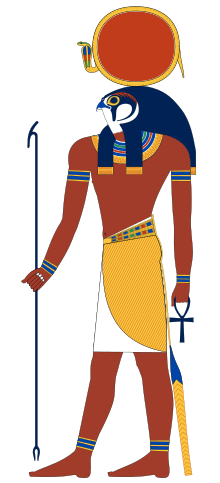 In one of his many forms, Ra, god of the sun, has the head of a falcon and the sun-disk inside a cobra resting on his head. | |||||||||||
| Name in hieroglyphs |
or
or
| ||||||||||
| Major cult center | Heliopolis | ||||||||||
| Symbol | Sun disk | ||||||||||
| Genealogy | |||||||||||
| Parents | None (self-created), alternatively Neith (in some accounts) or Ptah (in others) | ||||||||||
| Siblings | Apep, Sobek and sometimes Serket | ||||||||||
| Consort | Hathor, Sekhmet, Bastet and sometimes Satet | ||||||||||
| Offspring | Shu, Tefnut, Hathor, Sekhmet, Bastet, Satet, Ma'at and sometimes Serket | ||||||||||
| Set | |
|---|---|
 | |
| Major cult center | Ombos |
| Symbol | Was-sceptre, Set animal |
| Genealogy | |
| Parents | Geb, Nut |
| Siblings | Osiris, Isis, Nephthys, Horus the Elder |
| Consort | Nephthys, Anat, Astarte, Tawaret |
| Offspring | Anubis |
| Shu | ||||||
|---|---|---|---|---|---|---|
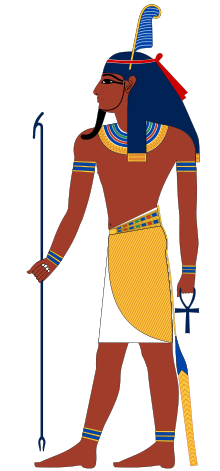 The ancient Egyptian god Shu is represented as a human with feathers on his head, as he is associated with light and air. This feather serves as the hieroglyphic sign for his name. Shu could also be represented as a lion, or with a more elaborate feathered headdress. | ||||||
| Name in hieroglyphs |
| |||||
| Major cult center | Heliopolis, Leontopolis | |||||
| Symbol | the ostrich feather | |||||
| Genealogy | ||||||
| Parents | Ra or Atum and Iusaaset | |||||
| Siblings |
Tefnut Hathor Sekhmet Bastet | |||||
| Consort | Tefnut | |||||
| Offspring | Nut and Geb | |||||
| Sobek | |||||||
|---|---|---|---|---|---|---|---|
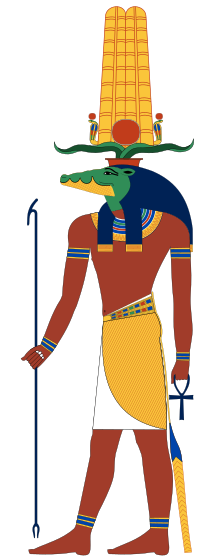 | |||||||
| Name in hieroglyphs |
or
| ||||||
| Major cult center | Crocodilopolis, Faiyum, Kom Ombo | ||||||
| Symbol | crocodile | ||||||
| Parents | Set/ Khnum and Neith | ||||||
| Consort | Renenutet or Meskhenet | ||||||
| ḏḥwty Thoth | |
|---|---|
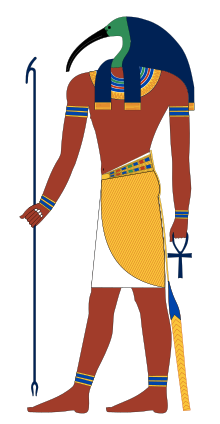 Thoth, in one of his forms as an
ibis-headed man | |
| Major cult center | Hermopolis |
| Symbol | Ibis, moon disk, papyrus scroll, reed pens, writing palette, stylus, baboon, scales |
| Parents | None (self-created); alternatively Neith or Ra or Horus and Hathor |
| Consort | Seshat, Ma'at, Nehemtawy |
| Offspring | Seshat in some accounts |
| Anuket | |||||
|---|---|---|---|---|---|
 The goddess Anuket, depicted as a woman with a tall, plumed headdress | |||||
| Name in hieroglyphs |
| ||||
| Major cult center | Elephantine, Seheil | ||||
| Symbol | Bow, arrows, gazelle, ostrich feather | ||||
| Parents | Khnum and Satet | ||||
| Amun | |||||
|---|---|---|---|---|---|
 | |||||
| Name in hieroglyphs |
| ||||
| Major cult center | Thebes | ||||
| Symbol | two vertical plumes, the ram-headed Sphinx (Criosphinx) | ||||
| Consort |
Amunet Wosret Mut | ||||
| Offspring | Khonsu | ||||
| Equivalents | |||||
| Greek equivalent | Zeus | ||||


| Anhur | |
|---|---|
 Anhur was depicted wearing a headdress of two or four tall feathers. | |
| Genealogy | |
| Parents | Ra |
| Siblings | Tefnut |
| Consort | Mehit |
| Anubis | ||||||
|---|---|---|---|---|---|---|
 The
Egyptian god Anubis (a modern rendition inspired by New Kingdom tomb paintings) | ||||||
| Name in hieroglyphs |
| |||||
| Major cult center | Lycopolis, Cynopolis | |||||
| Symbol | the fetish, the flail | |||||
| Parents | Nepthys and Set or Osiris (Middle and New kingdom), or Ra only (Old kingdom). | |||||
| Consort | Anput | |||||
| Offspring | Kebechet | |||||
| Atum | ||||
|---|---|---|---|---|
 Atum, finisher of the world | ||||
| Name in hieroglyphs |
| |||
| Major cult center | Heliopolis | |||
| Genealogy | ||||
| Consort | Iusaaset or Nebethetepet | |||
| Children | Shu and Tefnut | |||
| Geb | |||||
|---|---|---|---|---|---|
 | |||||
| Name in hieroglyphs |
| ||||
| Symbol | Geese, Snakes, Bulls, Barley | ||||
| Genealogy | |||||
| Parents | Shu and Tefnut | ||||
| Siblings | Nut | ||||
| Consort | Nut | ||||
| Offspring | Osiris, Isis, Set, Nephthys, and sometimes Horus. | ||||
| Horus | |
|---|---|
 Horus was often the ancient Egyptians' national
tutelary deity. He was usually depicted as a falcon-headed man wearing the
pschent, or a red and white crown, as a symbol of kingship over the entire kingdom of Egypt. | |
| Major cult center | Nekhen, Edfu |
| Symbol | Eye of Horus |
| Genealogy | |
| Parents | Osiris and Isis |
| Siblings | Osiris, Isis, Set, and Nephthys (as Horus the Elder), Anubis (as Horus the Younger) |
| Consort | Serket (as Horus the Elder), Hathor (in one version) |
| Offspring | Imset, Hapi, Duamutef, Qebehsenuef (as Haroeris), Ihy |
| Khnum | ||||
|---|---|---|---|---|
God of the source of the Nile river | ||||
 the Egyptian god Khnum was usually depicted with the head of a ram. | ||||
| Name in hieroglyphs |
| |||
| Major cult center | Elephantine | |||
| Symbol | the potter's wheel | |||
| Consort | Heqet, Satet, Mehet-Weret, Menhit, Nebtu, Neith | |||
| Offspring | Heka and sometimes Ra | |||
| Khonsu | ||||||
|---|---|---|---|---|---|---|
 Khonsu in human form | ||||||
| Name in hieroglyphs |
| |||||
| Major cult center | Thebes | |||||
| Symbol | the moon disk, the sidelock, falcon, crook and flail, was-scepter | |||||
| Genealogy | ||||||
| Parents | Amun/ Ra and Mut/ Hathor | |||||
| Siblings | Maat, Apis, Tefnut, Sekhmet, Bast, Shu | |||||
| Consort | Bast | |||||
| Khonsu | ||||||
|---|---|---|---|---|---|---|
 Khonsu as falcon | ||||||
| Name in hieroglyphs |
| |||||
| Major cult center | Thebes | |||||
| Symbol | the moon disk, the sidelock, falcon, crook and flail, was-scepter | |||||
| Genealogy | ||||||
| Parents | Amun/ Ra and Mut/ Hathor | |||||
| Siblings | Maat, Apis, Tefnut, Sekhmet, Bast, Shu | |||||
| Consort | Bast | |||||
| Montu, Monthu, Mentu or Menthu | ||||
|---|---|---|---|---|
 | ||||
| Name in hieroglyphs |
| |||
| Major cult center | Hermonthis, Thebes, Medamud, El-Tod | |||
| Symbol | Sun disk, feathers, weapons | |||
| Consort | Raet-Tawy, Tjenenyet, Iunit | |||
| Nefertem | ||||||
|---|---|---|---|---|---|---|
 the Memphite god Nefertem with a water-lily headdress as a symbol of fragrance and beauty. | ||||||
| Name in hieroglyphs |
| |||||
| Major cult center | Memphis | |||||
| Symbol | the water-lily | |||||
| Parents | Ptah and Sekhmet or Bast | |||||
| Osiris | ||||
|---|---|---|---|---|
 Osiris, lord of the dead, the underworld and rebirth. He had green skin because he ruled the dead, who "lived" on in the underworld. | ||||
| Name in hieroglyphs |
| |||
| Major cult center | Abydos | |||
| Symbol | Crook and flail, Atef crown, ostrich feathers, fish, mummy gauze | |||
| Genealogy | ||||
| Parents | Geb and Nut | |||
| Siblings | Isis, Set, Nephthys, Horus the Elder | |||
| Consort | Isis | |||
| Offspring | Horus, Anubis (in some accounts) | |||
| Ptah | |||||
|---|---|---|---|---|---|
 Ptah, in the form of a mummified man, standing on the symbol for Ma'at, holding a scepter or staff that bears the combined ankh-djed-was symbols | |||||
| Name in hieroglyphs |
| ||||
| Major cult center | Memphis | ||||
| Symbol | the djed pillar, the bull | ||||
| Parents | none (self-created or un-created) | ||||
| Consort | Sekhmet and Bast | ||||
| Offspring | Nefertem, Maahes | ||||
| Ra / Re | |||||||||||
|---|---|---|---|---|---|---|---|---|---|---|---|
 In one of his many forms, Ra, god of the sun, has the head of a falcon and the sun-disk inside a cobra resting on his head. | |||||||||||
| Name in hieroglyphs |
or
or
| ||||||||||
| Major cult center | Heliopolis | ||||||||||
| Symbol | Sun disk | ||||||||||
| Genealogy | |||||||||||
| Parents | None (self-created), alternatively Neith (in some accounts) or Ptah (in others) | ||||||||||
| Siblings | Apep, Sobek and sometimes Serket | ||||||||||
| Consort | Hathor, Sekhmet, Bastet and sometimes Satet | ||||||||||
| Offspring | Shu, Tefnut, Hathor, Sekhmet, Bastet, Satet, Ma'at and sometimes Serket | ||||||||||
| Set | |
|---|---|
 | |
| Major cult center | Ombos |
| Symbol | Was-sceptre, Set animal |
| Genealogy | |
| Parents | Geb, Nut |
| Siblings | Osiris, Isis, Nephthys, Horus the Elder |
| Consort | Nephthys, Anat, Astarte, Tawaret |
| Offspring | Anubis |
| Shu | ||||||
|---|---|---|---|---|---|---|
 The ancient Egyptian god Shu is represented as a human with feathers on his head, as he is associated with light and air. This feather serves as the hieroglyphic sign for his name. Shu could also be represented as a lion, or with a more elaborate feathered headdress. | ||||||
| Name in hieroglyphs |
| |||||
| Major cult center | Heliopolis, Leontopolis | |||||
| Symbol | the ostrich feather | |||||
| Genealogy | ||||||
| Parents | Ra or Atum and Iusaaset | |||||
| Siblings |
Tefnut Hathor Sekhmet Bastet | |||||
| Consort | Tefnut | |||||
| Offspring | Nut and Geb | |||||
| Sobek | |||||||
|---|---|---|---|---|---|---|---|
 | |||||||
| Name in hieroglyphs |
or
| ||||||
| Major cult center | Crocodilopolis, Faiyum, Kom Ombo | ||||||
| Symbol | crocodile | ||||||
| Parents | Set/ Khnum and Neith | ||||||
| Consort | Renenutet or Meskhenet | ||||||
| ḏḥwty Thoth | |
|---|---|
 Thoth, in one of his forms as an
ibis-headed man | |
| Major cult center | Hermopolis |
| Symbol | Ibis, moon disk, papyrus scroll, reed pens, writing palette, stylus, baboon, scales |
| Parents | None (self-created); alternatively Neith or Ra or Horus and Hathor |
| Consort | Seshat, Ma'at, Nehemtawy |
| Offspring | Seshat in some accounts |
| Anuket | |||||
|---|---|---|---|---|---|
 The goddess Anuket, depicted as a woman with a tall, plumed headdress | |||||
| Name in hieroglyphs |
| ||||
| Major cult center | Elephantine, Seheil | ||||
| Symbol | Bow, arrows, gazelle, ostrich feather | ||||
| Parents | Khnum and Satet | ||||